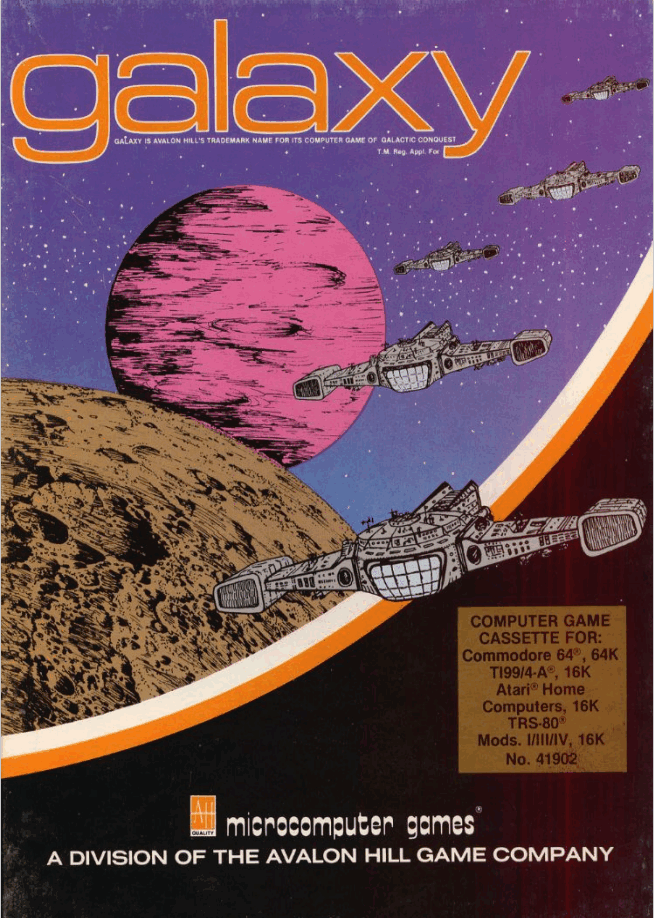
Well Lieutenant Narwhal – your skill in assisting space empire-building has been noticed. We have a new mission for you !
Thank you Sir ! I am ready to embark on any ship you deem me worthy of, sir !
Ship ? Ah no, no. We need a ship counter, really. Are you proficient with Excel ?
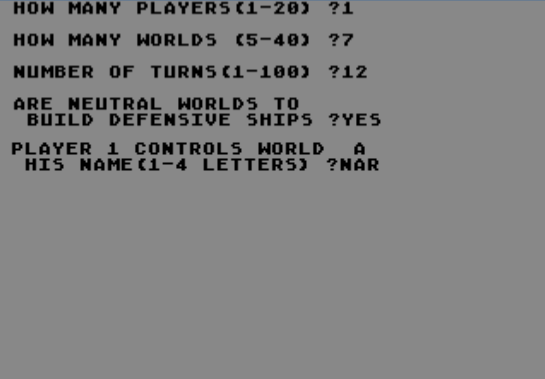
Galactic Empires is a strategy game developed by Tom Cleaver. It was first sold personally by Cleaver (for $2 he would send you the code!), then published in 1979 by Powersoft. The game did not sell well, and Tom Cleaver looked for a better publisher : Avalon Hill, which released the game (with some modifications) again under the name Galaxy in 1981. I played this later version.
Fundamentally, Galactic Empires is a multiplayer and barebones Galactic Empire (without -s, the one from Brøderbund) : the player controls a certain number of worlds (called “star systems”) which automatically produce a number of starships every turn, which can then be sent to conquer more worlds. The key-word is multiplayer though: the game was made to be multiplayer, and the single-player mode is, well, lackluster.
For the purpose of this AAR, I chose a tiny universe : 7 star systems. I give myself 12 turns to conquer them, and let the neutral worlds build their own ships (the only way for a single player game to have a modicum of interest).
The world is generated :
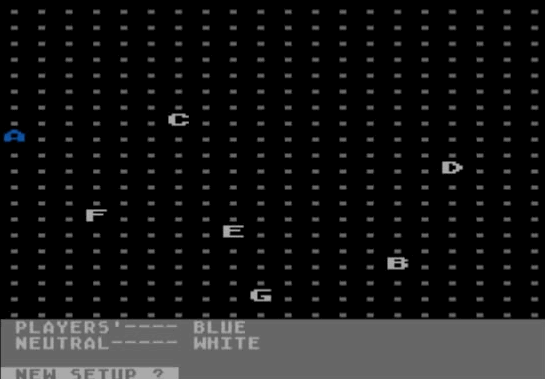
I start with 67 ships, that I immediately send to star system C. It will take them 3 turns to arrive.

The following turn, I have 10 ships available in my home system (as it produces 10 ships a turn). I send one of them in every other system (except C) to have a general idea about their defensive capacity.
Two turns later, my fleet arrives in World C. There are only 13 ships in defense, and even though defenders always shoot first they don’t have much of a chance :
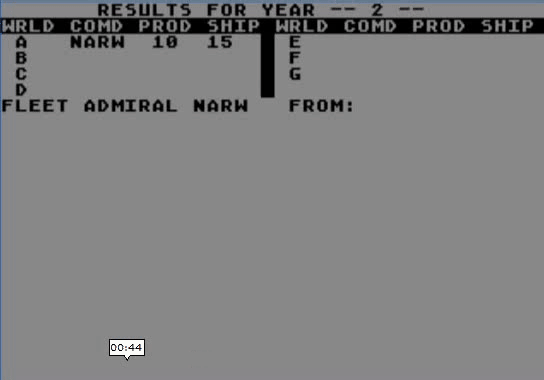
Before leaving C for a new target, I prefer to wait for the reports of my suicide scouts.
The following turn, my suicide-scout arrives in World F.
The good news is that … it conquers it. It turns out it was defended by only one unit :
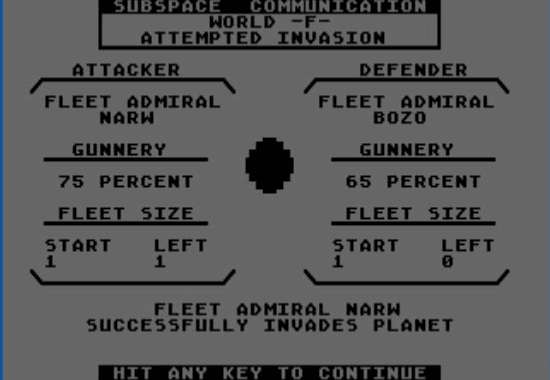
The bad news is that I still do not have a target for my main battle fleet.
The following turn, my suicide-scout targeting E properly does its job and dies against 15 defenders. My main battle fleet finally has a target.
The last reports from my scout arrive while my fleet is on the move : 10 defenders in B, 9 in D and 6 in G.
Also E is conquered. Obviously.

My fleet is powerful enough to wipe the few defenders of B, D and G, but I have only 4 turns left.

This forces me to improvise a bit, and minimize the “longest distance traveled” thanks to this GENIUS plan.

And eventually I conquered all those systems, just in time !

You may think it was easy… yes maybe, but I was more stringent than the manual proposes :
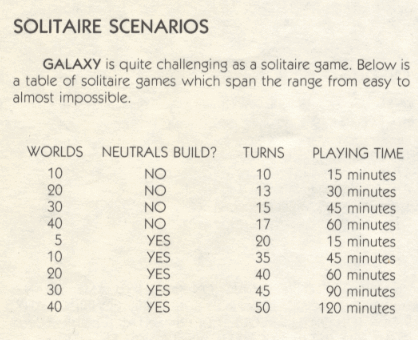
Full disclosure – initially my AAR was 15 worlds in 30 turns – and I lost. But no way could I keep anyone’s interest alive for that.
Review & Rating
Galactic Empires and Galaxy by Tom Cleaver
First release : 1979 on Apple II
Tested on : Atari, Apple II, Ti99/4A
Total Hours Tested : 2 hours
Average duration of a battle : Variable
Complexity : Trivial (0/5)
Would recommend to a modern player : No
Would recommend to a designer : No
Final Rating: Not rated, not designed for single player
Galactic Empires / Galaxy had three versions :
- The original 1979 version, “Galactic Empires”
- No manual, but instructions included in the game,
- Battles don’t have “gunnery factor,” or more probably they have it but it is hidden :
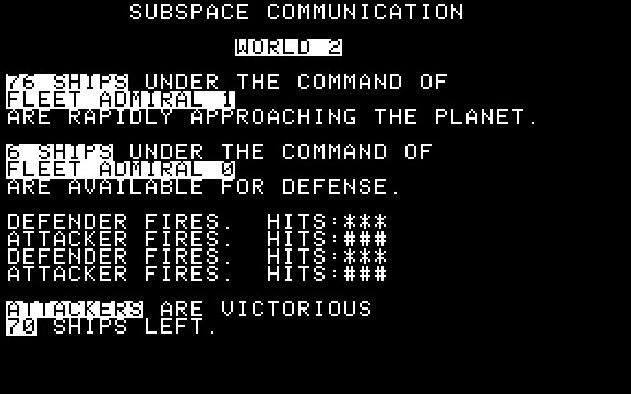
- The Avalon Hill 1981 version : “Galaxy”
- Rules not included in the code ; they are in the manual,
- You can save your game,
- Minor UI changes, the most meaningful one is that you can name your admiral,
- The map displays which worlds you control,
- Clearly displayed gunnery factor during combats,
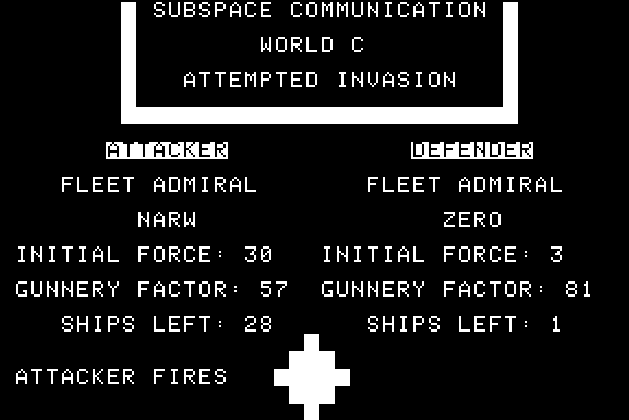
- The Avalon Hill 1983 port for Ti99/4A, also “Galaxy“, but it is different enough to be considered a third version :
- 26 worlds maximum,
- Major UI changes – the map is always displayed, including in combat – the drawback is that you cannot have an overview of all your worlds, you need to query status world by world,
- The most differentiating factor : the “neutral” worlds can attack you – sometimes en force (50+ units in one case as I tested).
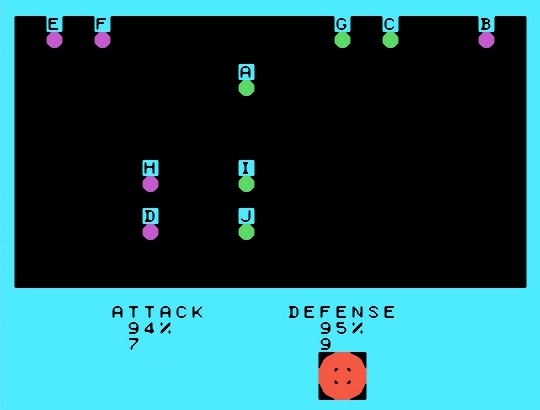
I thank the person from ArcadesShopper who helped me with the Ti99/4A emulator.
Galaxy is a multiplayer game with a high focus on diplomacy : Cleaver notes that his inspirations were Diplomacy, Risk and (in my opinion the odd one out) Star Trek.
I will review it for its single-player, but as the game was fully designed for multiplayer, with “single player” added because it was absolutely free in development time, I don’t believe I should rate it.
Once again, I have a glimpse of the multiplayer experience thanks to the Data Driven Gamer, who played both Galaxy and Galactic Empires – on the initial Apple version. He also played solo a lot more than I did.
A. Immersion
None.

B. UI , Clarity of rules and outcomes
The game made the dubious decision to hide your own orders from yourself, so people could not check out your screen. But that’s a good way to frustrate players with something that should have been solved by, you know, just telling other players not to look at your screen.
In general, the UI is frustrating : no reminder of how many units still need to be deployed (except on Ti99/4A), no way to check what are your forces “en route”, no way to set up a “rallying point” for your new production…
C. Systems
I could accept the randomness of the map, of the level of defense of each world – but the randomness of “gunnery factor” is just aggravating.
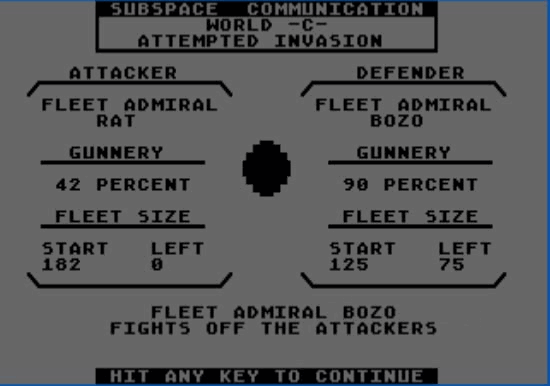
Overall, it is just dry, though at least turns are fast. I don’t feel like there is much strategy except waiting for troops to accumulate – at least in single player. As I said, I am sure that in multiplayer there is a lot more you can do with so few parameters – after all Risk is not that much more complex.
D. Scenario design & Balancing
As I explained, pretty much N/A. At least the game allows you to reject star maps you don’t like at the beginning, and to set up your own challenges.
E. Fun and replayability
Well, as you can imagine, neither fun nor replayable alone.
Contemporary Reviews
Bruce Webster from the Space Gamer covered Galactic Empires in a “featured review” in issue 31 (September 1980) . Webster complains a bit about the lack of manual and the quality of the cassette Powersoft uses (“the distributor has a reputation for less-than-adequate cassettes”) , but states it clearly :”the game is (1) playable (2) exciting (3) FUN! It is one of the five best computer games and easily the best multiplayer game I have ever seen“. In issue 61 (March 1983), the Space Gamer returns to the game, under the name Galaxy this time, and remains consistent. Dana Hold states : “Played Solitaire, the game rapidly becomes predictable […] the attraction of the game [is] the variety of player interaction. In the multiplayer computer games market, there are not that many games. This is a welcome addition to that collection.“
The respect for Galactic Empires / Galaxy‘s multiplayer is shared by Computer Gaming World. Introducing an article where Tom Cleaver talks about his game, Russel Sipe calls it “still the best multiplayer game available for personal computer” (January-February 1982).
Obviously, reviewers who did not “get” the multiplayer nature of the game rarely shared those opinions. In particular, PC Magazine (December 1982) pans the game : “Galaxy lacks excitement and it is relatively unimaginative. Even reruns of Star Trek have more compelling sequences“.
Long story short : play it multiplayer, or don’t play it.
In other news :
- The Data Driven Gamer reviewed Galactic Trader, and we had a friendly competition where we would try to get the best performance in a blind run on the same seed. You can also find a description of my own run here but warning, it is dry and more for people who played the game already !
- I have covered a lot of space games lately, but if everything goes well, we should be back to good old Earth in the coming articles.
5 Comments
73 attackers only do 3 hits ?
To-hit calculations are weird. In Galactic Empires, odds are:
80% * Defenders / (Attackers + Defenders) + 3%
No random gunnery factor.
For 73 attacking 6, that comes out to 9% chance of a hit, so you might expect 6-7 hits, except that once the first hit is scored, now there are only 5 defenders, and so on. 3 hits is still lower than expected, but not grossly.
Wow. Fleet Admiral Bozo. I know I’ve seen this before. It unearthed distant memories of some of the oldest computer games I played. It can’t be this game, though, I never had an Apple II (I guess? It doesn’t say). My first computer was a PC, Compaq portable with dual floppy drives that Dad took home from work on weekends. The name had to have been re-used in a later title.
Even reruns of Star Trek have more compelling sequences
I remember that era. Star Trek was all we nerds had. You could watch the reruns…or starve. Your choice.
A cursory google search reveals a 1959 cartoon episode titled “Admiral Bozo Beats The Fleet” (https://www.imdb.com/title/tt1581347/fullcredits) but that’s probably unrelated.
Nah, it was definitely from some space conquest game I played. No idea what it might have been though. The stark text seems familiar. No way it was this game though because it had to have been on PC.
The game was ported to IBM PC. He mentions a PC Magazine review of the game. They only reviewed products for IBM PC, ofc. I assume by “I guess? It doesn’t say,” you mean that this webpage doesn’t mention what platform it was tested on–but it does. The AAR is on the Atari HCS.